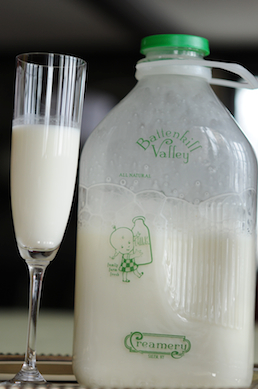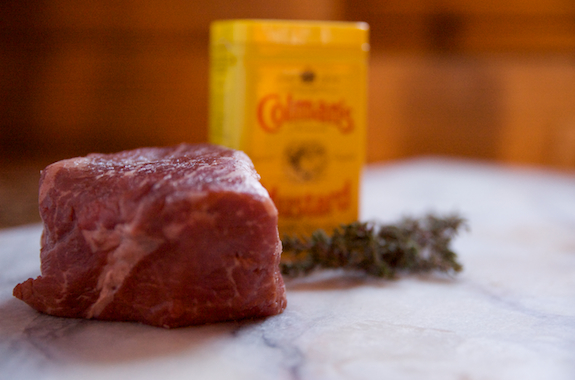The Miracle of Pricey Eats
Posted by Jill | January 26, 2011 | Filed under: Home, Ingredients
I pay about $8/gallon for milk. I pay around $15 for a roasting chicken. I buy NY strip steaks that cost $16 each. I can see you getting all bug-eyed as you read this. There was a woman who used to stop by when Steve, my Hinsdale hook-up for farm-fresh meat, sold meat from my driveway in the off-season. She came by on occasion just to look. Her husband “wouldn’t let” her buy such expensive meat. “A pig is a pig is a pig,” he insisted.
I know that I pay a helluva lot more for the dairy, meat and produce we eat than other families with similar family incomes. No matter. My food budget is probably the same my neighbor’s.
How can that be?
I’m taking you back to Econ 101; try not to fall asleep just yet. In the first week of any Intro to Econ class, you’ll learn about the “elasticity of demand:” as the cost of an item increases, people adjust by consuming less of that item. When gas prices skyrocket, we hear all kinds of stories about commuters migrating towards public transportation and carpooling. You know this principle.
Because I pay $8 for a gallon of milk, I pour only what my kids need and will drink at dinnertime. I don’t let them drown their cereal in it. Rather, I make sure they use just what they need and then insist that they drink what’s left when the cereal is gone.
Because I buy steaks at $16 each, I think really hard about how many of them my family will- or should- eat before I pull them from the freezer and defrost them. Sometimes I even poll the kids about just how hungry they are. Ample produce-based side dishes cover any appetite miscalculations.
Because I buy chickens that cost $15-20 or more, I make the most out of them. One bird provides one meal of roasted chicken as well as a meal that consists of chicken “pickin’s” (any leftovers and any bits that I can pull off the bones). As a final bonus, I save all of bones for stock.
Because I buy quality ingredients, I only buy perishables that I know I will use. Okay, sometimes I do make an impulse buy (Cardoons, anyone?), but if I do, I put them in the front of my refrigerator in a little basket so I can be constantly reminded to figure out how to use them.
Because meat is expensive, I balance out the week’s food budget with one or two vegetarian dinners. Further, I usually only serve meat for dinner.
Because I value the quality and effort that go into the dishes I make, I don’t serve my family excessive portions. If I’m plating in the kitchen, they get a minimal portion- which often looks absurdly small- that they are required to eat before they are excused from the table. Of course, they are welcome to take seconds and the older kids often do. If we’re serving family-style, the kids are responsible for taking only what they will eat and eating whatever they take. Leftovers are almost never thrown away. They are either repurposed for lunch or become part of the freezer stash.
Waste control is the linchpin of our little food economy. Waste comes in two forms: food disposed of in the garbage and food disposed of in the human body. When you eat beyond satiety- the point at which you feel pleasantly full- you’re simply disposing of food in your body. Yup, you’re treating your body like a trash can. Think again when you try to make yourself feel better that you haven’t wasted food because it was all eaten.
There’s a miracle in all of this thrift. We are healthier for it. Our diet has inadvertently aligned itself pretty closely with the best-established nutritional guidelines. Meat contributes a much smaller proportion of our caloric intake. We eat lots of whole grains, produce and meatless protein sources. Our portions are in check. We eat slowly together at the dinner table so that we have time to develop a sense of satiety. In fairness, some of these things were initially very conscious choices, but their contribution to our food economy is strongly reinforcing.
Unlike most of the families I know, we eat with gratitude and appreciation. I don’t say this to be smug, just observationally. We savor our food. We talk about the work and sacrifice that went into producing it. When dining with other families, I often wince at the amount of milk dumped down the drain. I am dismayed to watch platefuls of food that are being glibly scraped into the garbage disposal. I feel sad when the family cook offers a kid a bowl of cereal because she didn’t want to eat the lasagna because there were bell peppers in it.
I once watched a mom make a grilled cheese sandwich for her child, who then said she wanted it on a different kind of bread. Mom didn’t hesitate to toss the sandwich and remake it on the requested bread. In all fairness, the cost of the sandwich was probably about a quarter. It is somewhat rational for mom not to endure the fuss for a quarter. However, the child learns something from this interaction: food is worthless.
There’s a compelling case to be made that we’re being environmentally friendly, too. That’s just another happy accident.
This post begs the question, “Why exactly are you paying $8 for your milk?” Is it an organic thing? A humanitarian thing? An environmental thing?
Stay tuned. I’ll post that answer next week.







Oh, there are so many yummy things. Quiche is always a good way to go, super-easy and cheap. In fact, I’ll often just put leftover veggies and some cheese in, pour some egg over it and see what happens. Loooove veggie burgers. Love “brothless soups:” which are another great, easy way to get rid of leftover veggies. Stuffed shells are winners too. And dashi-based soups. And grilled veggie paninis. And then there’s always a pasta tossed with some great veggies.
This all sounds very familiar. For environmentla,health, and financial reasons, I limit red meat to once a week (one steak feeds four of us-granted #s 3 & 4 are 1 and 3 but…) throw in veg. meals, and buy organic chicken on sale and freeze it. Do you have favorite “go tos” for vegetarian meals that will sastify a high metabolism carnivore? I incorporate beans, brown rice, pasta, etc. but need more ideas. Thanks!